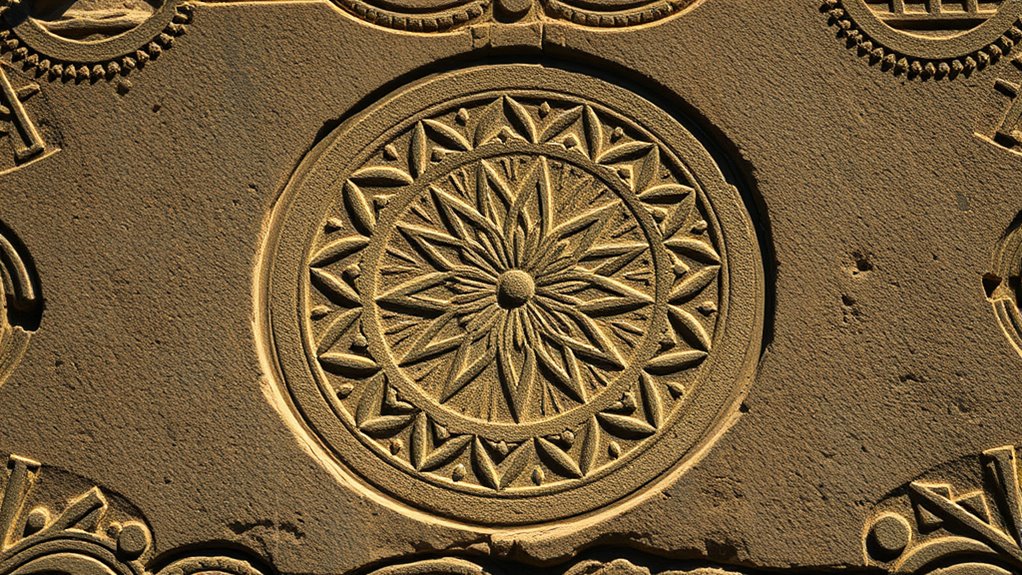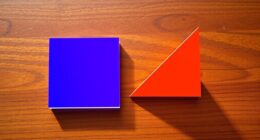Sacred geometry is often seen as a divine blueprint behind natural patterns, but many misconceptions link it solely to mystical beliefs. Historically, ancient civilizations used geometric proportions like the golden ratio to symbolize spiritual harmony and create impressive architecture. Over time, some have misunderstood these symbols as purely mystical, ignoring scientific insights. Exploring its true origins reveals a blend of spirituality and science, offering a deeper understanding that can reshape your perspective on universal patterns. Keep exploring to uncover more about its fascinating history and meanings.
Key Takeaways
- Sacred geometry’s historical interpretations link geometric patterns to spiritual and cosmic principles in ancient cultures.
- Misconceptions often arise from equating geometric symbols solely with divine meanings, ignoring scientific and natural explanations.
- The golden ratio and other sacred proportions are rooted in natural phenomena, not exclusively divine or mystical origins.
- Modern reinterpretations sometimes secularize sacred geometry, reducing it to mathematical curiosity rather than spiritual symbolism.
- Understanding its history reveals both spiritual significance and scientific foundations, clarifying common misconceptions.
Origins of Sacred Geometry in Ancient Civilizations
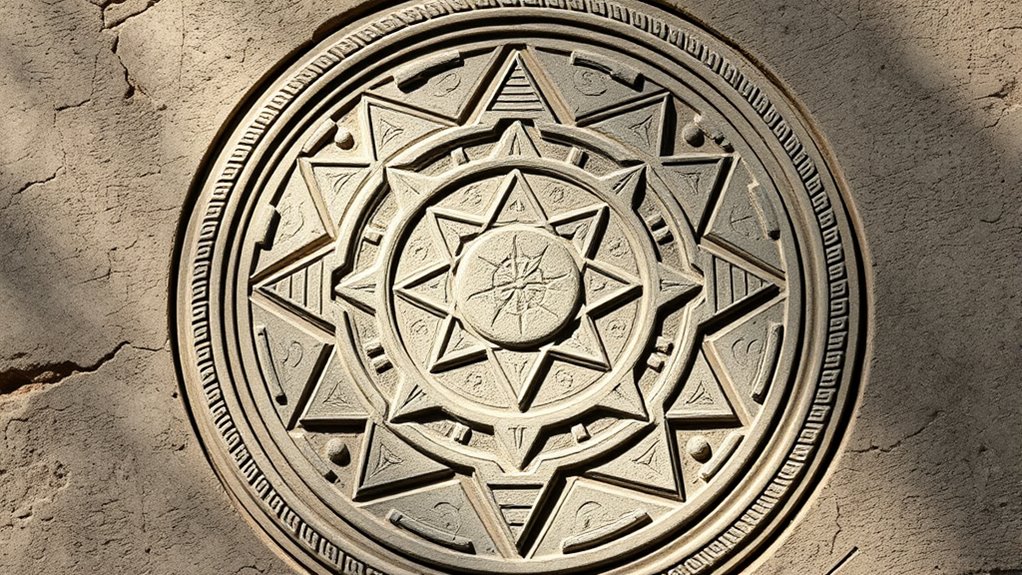
Ancient civilizations discovered that certain geometric patterns and proportions held special significance, forming the foundation of what we now call sacred geometry. These patterns often appeared in their art, architecture, and rituals, reflecting deep-rooted beliefs about the universe. Ancient symbolism played a pivotal role, as these shapes represented divine concepts or cosmic principles. Cultural symbolism embedded in geometry helped societies connect with higher powers or natural forces, elevating everyday objects into sacred tools. For example, the Egyptians used geometric ratios in their pyramids, symbolizing spiritual ascent, while the Greeks associated specific shapes with harmony and balance. The use of specific geometric ratios in their constructions demonstrated an understanding of mathematical harmony and its spiritual significance. By recognizing these geometric principles, ancient peoples expressed their understanding of the cosmos, creating a visual language that conveyed profound spiritual and cultural meanings.
The Role of Geometry in Religious and Spiritual Practices
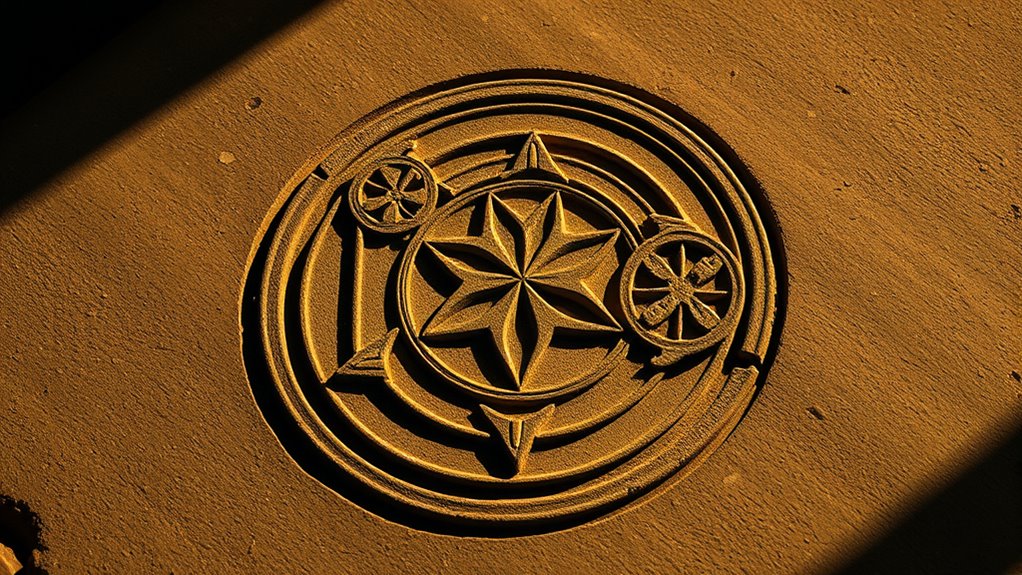
Sacred geometry has long served as a bridge between the physical and spiritual worlds, shaping religious and spiritual practices across cultures. You recognize how numerical symbolism plays an essential role, with specific numbers representing divine principles or spiritual truths. Mystical proportions, such as the golden ratio, are often used to create harmony in sacred spaces and artifacts, reflecting a deeper universal order. These geometric concepts help practitioners connect with higher consciousness, guiding rituals and meditation. You might notice how temples, mandalas, and icons incorporate precise proportions to evoke spiritual enlightenment. By understanding the importance of these principles, you see how geometry serves as a language of the divine, facilitating a profound sense of connection and transcendence within spiritual practices. Additionally, the use of proportions in sacred architecture underscores the harmonious relationship between math and spirituality, enhancing the spiritual experience.
Symbolism and Meaning Behind Key Geometric Patterns
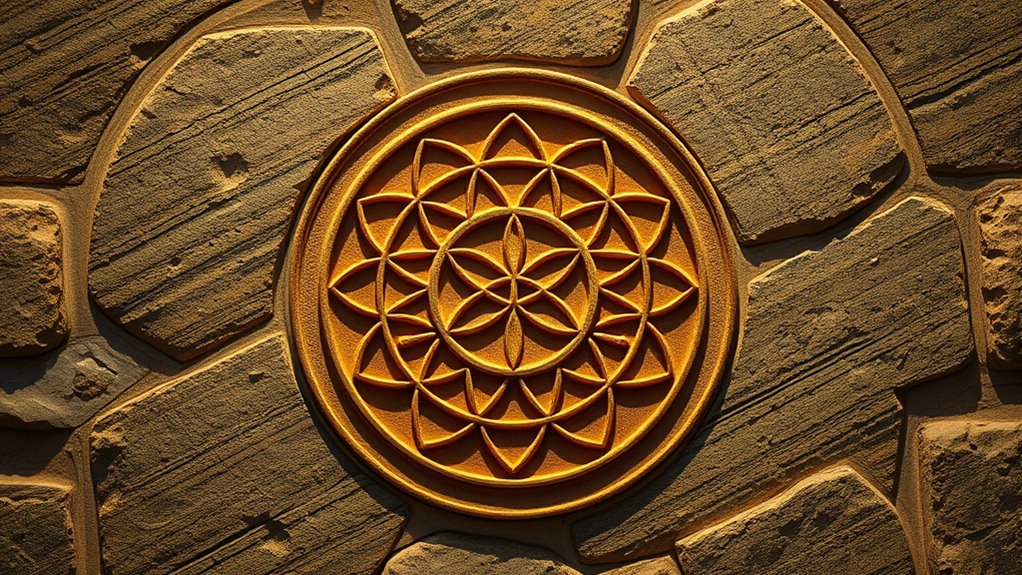
Many key geometric patterns carry profound symbolic meanings that communicate universal truths and spiritual concepts. These patterns serve as visual language, conveying ideas beyond words through geometric symbolism. When you interpret these patterns, you might see:
- The circle, representing wholeness and unity, emphasizing the interconnectedness of all life.
- The spiral, symbolizing growth, evolution, and spiritual journeying through pattern interpretation.
- The vesica piscis, illustrating balance, harmony, and the union of opposites.
The Influence of Sacred Geometry on Architectural Marvels
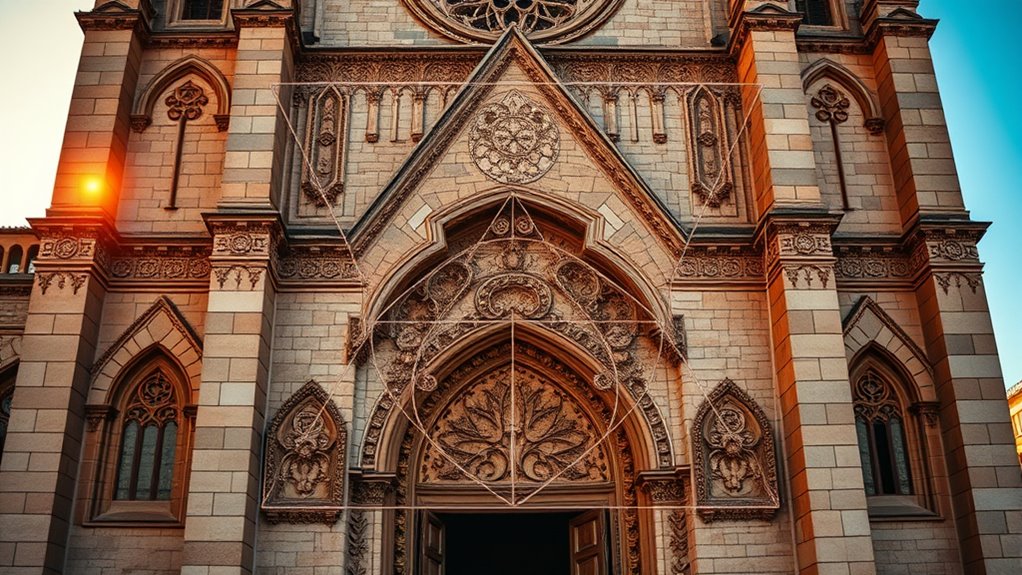
You can see sacred geometry reflected in the precise layouts of cathedrals and monuments, where geometric principles guide design and harmony. These patterns create a sense of balance and spiritual connection that resonates through their architecture. By exploring these structures, you’ll discover how sacred patterns shape their enduring beauty and significance. Additionally, understanding the geometric principles behind these designs reveals the deep connection between mathematics and spiritual symbolism in architecture.
Geometric Principles in Cathedrals
Architects of cathedrals harnessed sacred geometry to create structures that embody both spiritual symbolism and aesthetic harmony. Through symmetry analysis, they achieved balanced proportions that evoke divine order. Geometric symbolism is visible in features like rose windows and vaulted ceilings, reflecting universal patterns. Visualize these elements:
- The central nave aligning perfectly with side aisles, forming a harmonious axis.
- The intricate tracery of stained glass windows, echoing sacred ratios.
- The soaring spires, embodying the tetrahedral or pentagonal forms found in nature. These principles guide the layout and ornamentation, ensuring each element resonates with deeper spiritual meaning. Recognizing geometric principles in architecture reveals how divine order is translated into physical form. Sacred geometry’s influence emphasizes the interconnectedness of form and symbolism, elevating these cathedrals into architectural embodiments of divine harmony.
Sacred Patterns in Monuments
Sacred geometry’s influence extends beyond cathedrals into the design of monumental structures worldwide, shaping their form and symbolism. You can see pattern symbolism clearly in iconic monuments like the Pyramids of Egypt or Machu Picchu, where geometric ratios convey spiritual significance. These patterns guide monument design, creating harmony, balance, and a sense of divine order. Architects intentionally incorporate sacred proportions to evoke awe and connect viewers to higher principles. The use of circles, squares, and spirals in these structures isn’t accidental; it reflects ancient beliefs about the universe’s sacred structure. By understanding these sacred patterns, you recognize how monument design communicates spiritual truths and cultural values, transforming mere architecture into expressions of cosmic harmony rooted in sacred geometry. Recognizing the geometric ratios used in these monuments helps us appreciate their deeper symbolic meanings and the intention to reflect universal harmony.
Early Philosophers and Mathematicians’ Contributions

- The Golden Ratio, representing harmony and beauty, found in shells and galaxies.
- The Vesica Piscis, a sacred shape symbolizing unity and balance in philosophical symbolism.
- The Fibonacci sequence, illustrating growth patterns in plants and cosmic spirals.
These contributions helped shape the idea that geometry reflects universal principles. Their insights connected mathematical ratios to spiritual and philosophical symbolism, laying a foundation for later interpretations of sacred space and cosmic order.
Misinterpretations and Mystical Attributions Throughout History

Throughout history, many interpretations of sacred geometry have been distorted or exaggerated, often blending fact with myth. Esoteric symbolism has fueled mystical beliefs, leading people to see deeper, hidden meanings where there may be none. Misattribution myths, such as assigning divine or supernatural powers to simple geometric ratios, have perpetuated the idea that these shapes hold secret universal truths. These misunderstandings have caused sacred geometry to be mystified, making it seem more mystical than mathematical. As a result, many have overlooked the original intent: understanding natural patterns and proportions. Instead, they’ve assigned mystical significance, creating a narrative that often distorts historical facts. Recognizing these misinterpretations helps you see sacred geometry as a tool for enlightenment rather than a source of mystical myths. Emphasizing the importance of scientific accuracy can help distinguish between genuine mathematical principles and unfounded mystical claims.
The Shift From Sacred to Secular Understandings
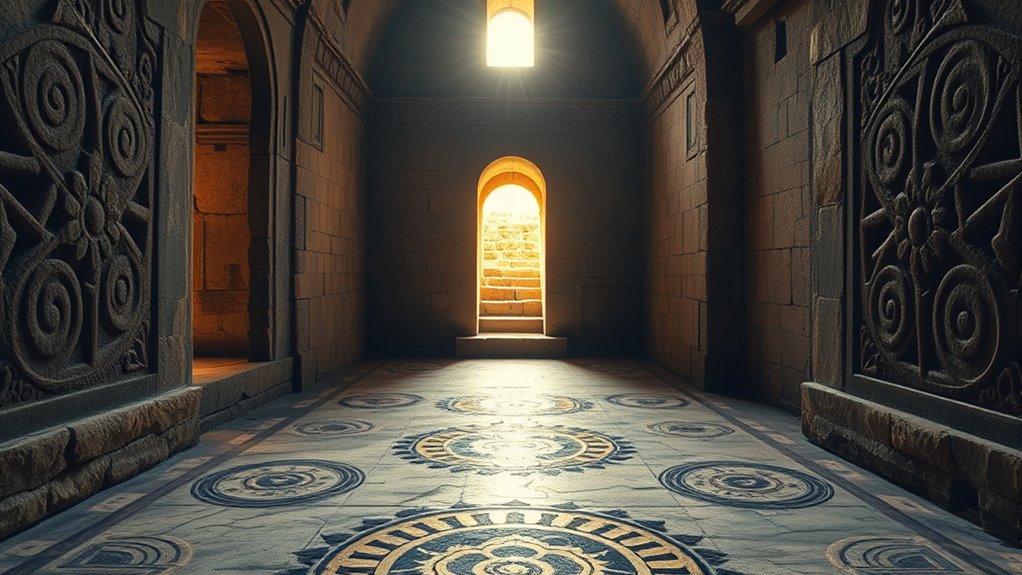
As the centuries progressed, the understanding of sacred geometry gradually shifted from its spiritual roots toward a more secular, scientific perspective. During this metamorphosis, people began to approach geometric principles with scientific skepticism, questioning mystical claims. Instead of viewing these shapes as divine symbols, scholars focused on their mathematical properties and natural patterns. You might envision this shift as:
- Researchers analyzing the ratios that appear in nature, like sunflower spirals or pinecones.
- Mathematicians deriving formulas to explain geometric proportions.
- Skeptics dismissing spiritual significance, emphasizing empirical evidence.
- The development of automation technologies to analyze complex geometric data more efficiently.
This movement fostered secular interpretations, transforming sacred geometry into a tool for scientific exploration. While the spiritual meaning waned, the fascination with universal patterns persisted, now grounded in observable phenomena rather than divine symbolism.
Sacred Geometry in Modern Esoteric and New Age Movements
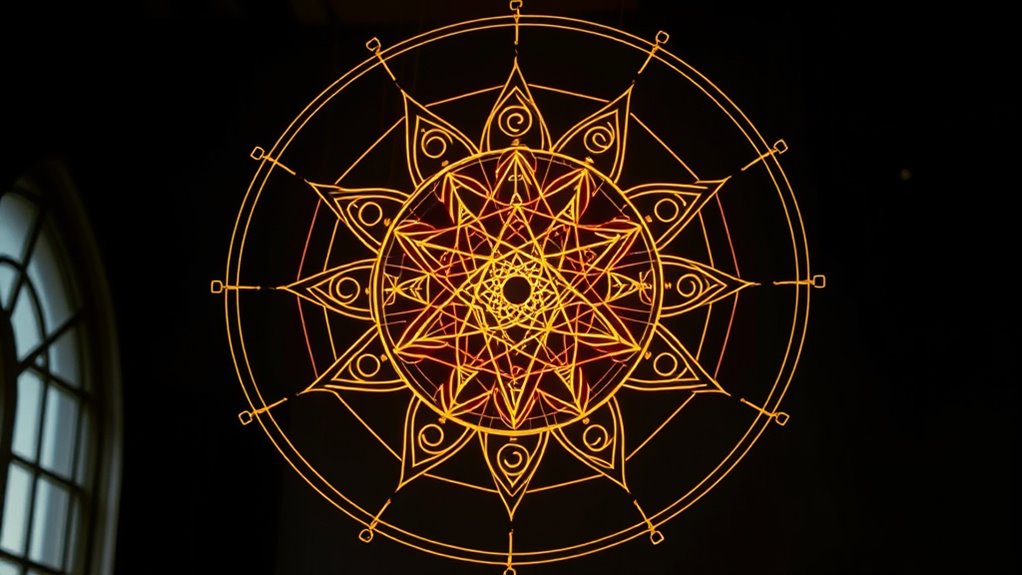
In modern esoteric and New Age movements, sacred geometry has experienced a resurgence as a symbol of spiritual connection and universal harmony. Practitioners often use meditative visualization, focusing on geometric patterns like the Flower of Life or the Fibonacci spiral to deepen their spiritual awareness. These symbols serve as tools to access higher consciousness and reinforce a sense of unity with the cosmos. Many believe that engaging with sacred geometry reveal hidden truths, emphasizing its role as spiritual symbolism rather than just mathematical forms. You might find yourself drawing or contemplating these patterns during meditation, feeling their energy resonate within. This modern reinterpretation transforms sacred geometry into a personal pathway for spiritual growth, emphasizing its relevance as a bridge between physical and divine domains. Additionally, understanding geometric symbolism can enhance one’s appreciation of its historical and cultural significance across civilizations.
Scientific Perspectives and Rational Explanations

You can explore how mathematical principles underpin sacred geometry, revealing precise patterns in nature. Evidence of these natural patterns supports the idea that sacred geometry has a rational basis. By examining these mathematical foundations, you gain a clearer understanding of how science explains the structures around us. For instance, Kia Tuning demonstrates how precise adjustments can optimize performance by aligning with underlying mechanical principles.
Mathematical Foundations Explored
Mathematical principles provide the backbone for understanding sacred geometry, revealing patterns and proportions that underlie natural forms. By examining the mathematical foundations, you discover how geometric ratios shape our environment and art. These ratios, like the golden ratio, exhibit properties such as:
- Fibonacci sequence, where each number is the sum of the two preceding ones, creating spirals seen in shells and galaxies.
- Perfect proportions, where lengths relate through simple ratios, producing harmonious designs.
- Symmetrical patterns, where geometric ratios generate balance and order, reflecting universal principles.
– These ratios are also evident in notable architectural structures that have stood the test of time, demonstrating their significance across cultures and eras.
Understanding these ratios helps you see how ancient civilizations encoded meaning through mathematics. The rational explanations grounded in geometry highlight the universal language connecting math and nature, dispelling myths with scientific clarity.
Natural Pattern Evidence
Scientific research provides compelling evidence that natural patterns reflect underlying geometric principles. Fractals in nature, such as branching trees, coastlines, and snowflakes, display complex, self-similar structures that follow specific mathematical rules. Natural symmetry appears across diverse ecosystems, from the radial symmetry of flowers to the bilateral symmetry of animals. These patterns aren’t random; they reveal an intrinsic connection to geometric concepts that optimize efficiency, growth, and stability. By studying these natural patterns, scientists uncover how underlying geometric principles shape the world around us. This rational approach demonstrates that sacred geometry isn’t merely symbolic but rooted in observable, natural phenomena. Recognizing these patterns helps us appreciate the deep relationship between geometry and the biological world, bridging scientific understanding with ancient interpretations. Additionally, the presence of Natural symmetry across various species highlights the fundamental role that geometric principles play in biological development and evolution.
Continuing Cultural Impact and Contemporary Applications
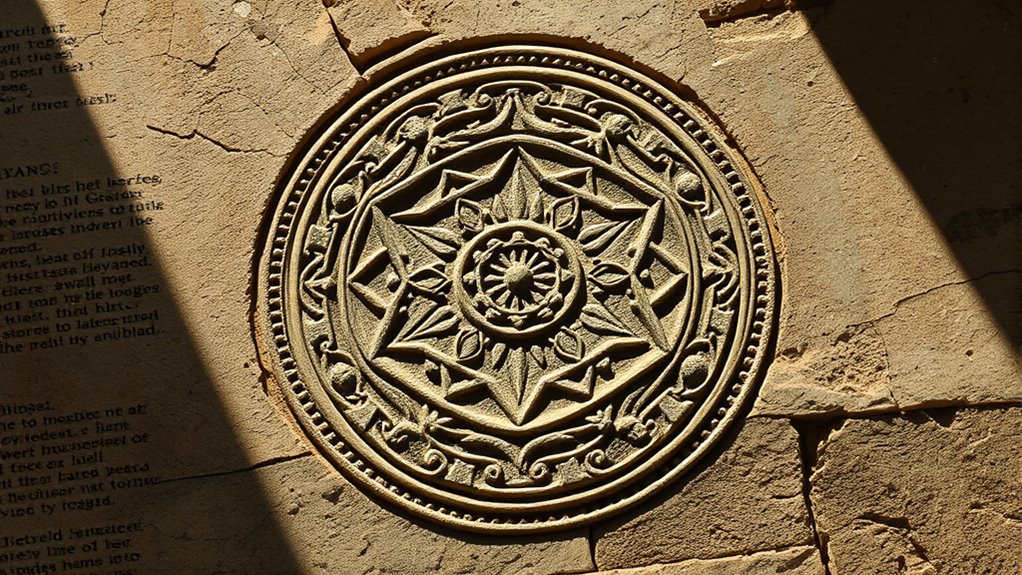
Despite its ancient origins, sacred geometry continues to influence modern culture and design in diverse ways. You see its impact in modern art, where artists use geometric patterns to evoke spirituality and harmony. Technological innovations also harness sacred principles, leading to precise digital designs and architectural structures. To visualize its ongoing influence: 1. Artists incorporate sacred patterns into murals and sculptures, blending tradition with innovation. 2. Architects design buildings using geometric ratios, creating spaces that feel balanced and sacred. 3. Tech developers develop algorithms inspired by sacred geometry for visual effects and virtual environments. Additionally, curly iron styling techniques are sometimes inspired by geometric principles to create unique textures and patterns on surfaces. Your daily environment reflects these influences, reminding you that sacred geometry remains a crucial part of contemporary creativity and technological progress. It bridges past beliefs with today’s innovations, shaping how you perceive space, art, and design.
Frequently Asked Questions
How Does Sacred Geometry Influence Modern Art and Design?
You see how sacred geometry influences modern art and design through its symbolic meanings and aesthetic principles. It guides your choices in proportions, patterns, and structures, creating a sense of harmony and balance. Artists and designers often use sacred geometric shapes to evoke spirituality or connect viewers with deeper meanings. By incorporating these elements, you can enhance visual appeal and imbue your work with timeless significance.
Are There Any Scientific Experiments Validating Sacred Geometry’s Principles?
Imagine opening the universe’s secrets—scientific experiments like quantum studies explore fundamental patterns, offering mathematical validation for the principles behind sacred geometry. While some see these shapes as mystical, recent research hints at underlying mathematical structures that govern nature’s design. You can explore quantum experiments that test these patterns, revealing a fascinating bridge between ancient symbolism and modern science, inspiring awe at the universe’s hidden harmony.
Can Sacred Geometry Be Applied in Contemporary Technology or Engineering?
You can apply sacred geometry in contemporary technology or engineering through its mathematical applications, which inspire innovative designs and structures. By integrating these principles, you might enhance architectural efficiency, optimize signal processing, or develop new materials. While not always explicitly labeled as sacred geometry, these concepts influence technological innovations by offering unique geometric frameworks that improve functionality and aesthetic appeal in modern engineering projects.
What Are Common Misconceptions About the Mathematical Accuracy of Sacred Patterns?
You might think sacred patterns are perfectly precise, but many believe there’s a lot of mathematical precision in their design. However, authenticity debates question whether these patterns have exact mathematical accuracy or are just symbolic. It’s common to misunderstand these patterns as scientifically precise, but they often reflect spiritual or philosophical ideas rather than strict mathematical facts. Recognizing this helps you appreciate their cultural and symbolic significance more accurately.
How Do Cultural Differences Shape Interpretations of Sacred Geometric Symbols?
You might think sacred geometric symbols are universal, but cultural symbolism transforms their meaning dramatically. Your interpretation varies wildly because of interpretative diversity rooted in different traditions and beliefs. Across cultures, these symbols embody profound spiritual truths or local myths, making their significance as unique as each society. This rich diversity highlights how cultural context shapes interpretation, reminding you that sacred geometry isn’t just mathematical—it’s deeply woven into cultural identities worldwide.
Conclusion
As you explore sacred geometry, remember that it’s a double-edged sword—offering profound spiritual insights while tempting misconceptions. By understanding its rich history and scientific perspectives, you can see through the fog and appreciate its true essence. Don’t let myths steer you wrong; instead, keep an open mind and see the bigger picture. After all, knowledge is power, and sometimes, the truth is right under your nose.
